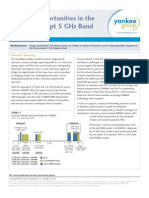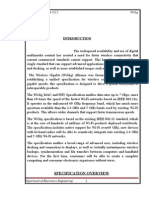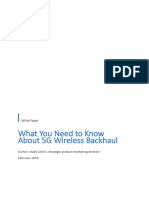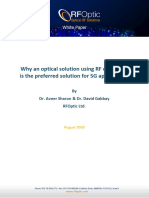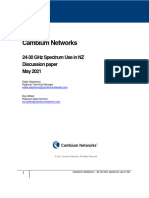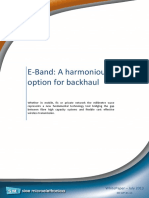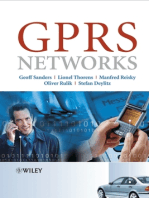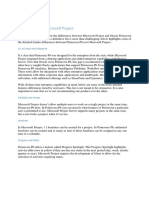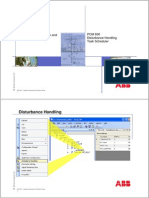Fixed Wireless Access and Backhaul With Unlicensed 60 GHZ: A Heavy Reading White Paper Produced For Adtran
Fixed Wireless Access and Backhaul With Unlicensed 60 GHZ: A Heavy Reading White Paper Produced For Adtran
Uploaded by
Irina SilesCopyright:
Available Formats
Fixed Wireless Access and Backhaul With Unlicensed 60 GHZ: A Heavy Reading White Paper Produced For Adtran
Fixed Wireless Access and Backhaul With Unlicensed 60 GHZ: A Heavy Reading White Paper Produced For Adtran
Uploaded by
Irina SilesOriginal Title
Copyright
Available Formats
Share this document
Did you find this document useful?
Is this content inappropriate?
Copyright:
Available Formats
Fixed Wireless Access and Backhaul With Unlicensed 60 GHZ: A Heavy Reading White Paper Produced For Adtran
Fixed Wireless Access and Backhaul With Unlicensed 60 GHZ: A Heavy Reading White Paper Produced For Adtran
Uploaded by
Irina SilesCopyright:
Available Formats
Independent market research and
competitive analysis of next-generation
business and technology solutions for
service providers and vendors
Fixed Wireless Access and
Backhaul with Unlicensed 60 GHz
A Heavy Reading white paper produced for ADTRAN
AUTHOR: STERLING PERRIN, PRINCIPAL ANALYST, HEAVY READING
INTRODUCTION
Millimeter wave technologies have emerged as an option not just for mobile 5G access,
but also for gigabit broadband to homes and business – and even as a backhaul choice for
5G. While most of the millimeter wave (mmWave) discussion centers on licensed spectrum
ranges being bought up by Tier 1 operators globally, an unlicensed band in the 60 GHz
range also exists.
This white paper examines unlicensed 60 GHz spectrum and its application in fixed wireless
access (FWA) and backhaul applications. The paper provides an overview of the fixed and
mobile broadband trends that are creating an opportunity for 60 GHz technology. It also
compares 60 GHz mmWave to both fiber access and licensed mmWave spectrum options
and identifies the key technical considerations in evaluating 60 GHz. The paper concludes
with a case study of a new service provider entrant, U.K.-based Ontix, that has based its
network and strategy on 60 GHz.
FIXED WIRELESS AND FIBER ACCESS
Global broadband speeds continue to accelerate. Ovum estimates that global average
broadband speeds hit 50 Mbps in 2017. As shown in Figure 1, they are forecast to exceed
270 Mbps by 2024. These are global averages; in developed regions, data rates will be
much higher. By 2024, for example, the average broadband speed in Hong Kong is
expected to hit 460 Mbps.
Figure 1: Global Broadband Subscriptions by Speed
Source: Ovum, Consumer Broadband Subscription and Revenue Forecast: 2019–24, 2020
© HEAVY READING | ADTRAN | FWA AND BACKHAUL | MARCH 2020 2
After 100 years, copper is reaching the end of its natural lifespan, but fiber is not always an
upgrade option. There have always been scenarios where urban fiber trenching is prohibited
by municipal regulations or it is so costly to obtain the necessary permits and install that
there is no business case for doing so. In more rural scenarios, meanwhile, population
density may be so low that the ROI on fiber is too long. In other scenarios, manmade or
natural obstructions may lay in the fiber path, preventing installation regardless of cost.
Until recently, there was no ultra-high bandwidth alternative to fiber. With the advent of 5G,
high data rate FWA has emerged to fill the gigabit broadband need when fiber is not an
option. Verizon is one example. The operator is using FWA for its Home Broadband service
in various markets, including Chicago, Houston, Los Angeles, Indianapolis, and Sacramento.
It is promising average downstream data rates of 300 Mbps and maximum rates of up to
1 Gbps. The operator has publicly stated that it plans to expand FWA to a total of 30 million
households over time (including five new markets in 2020).
60 GHz Unlicensed Spectrum
5G FWA is based on mmWave spectrum that falls roughly into the 30 GHz–300 GHz
frequency range, corresponding to wavelengths that span from 1 mm to 10 mm (thus, the
spectrum name). mmWave technology is an essential component of 5G because this
spectrum is uniquely capable of delivering the multi-gigabit data rates that 5G promises.
While midband spectrum provides range, high band provides capacity.
The majority of mmWave attention focuses on licensed spectrum bands that offer dedicated
operator use but at a cost of hundreds of millions of dollars – and more – for broad national
coverage. Verizon’s ultra-wide band 5G network, which includes both fixed and mobile 5G,
is based on 28 GHz and 39 GHz spectrum licenses. To put licensing costs in perspective,
Verizon has spent more than $3 billion over time collecting 28 GHz licenses alone (including
spectrum purchases and operator acquisitions).
In contrast to licensed spectrum, unlicensed spectrum is available for use free of licensing
fees. Unlicensed spectrum is not reserved for any specific user and thus is a shared use.
Within the mmWave bands, the 57 GHz–71 GHz spectrum range is unlicensed and requires
no government license for operator deployment. This unlicensed spectrum lies with the IEEE
V-band range and is commonly called 60 GHz.
Unlicensed 60 GHz spectrum is used commercially in communications today. The IEEE has
standardized the 60 GHz wireless spectrum, 802.11ad (known as WiGig), as a short-range
wireless replacement for cabling of video monitors and other computer equipment. WiGig
achieves data rates of up to 7 Gbps at very short ranges and is managed by the Wireless
Gigabit Alliance.
© HEAVY READING | ADTRAN | FWA AND BACKHAUL | MARCH 2020 3
Figure 2 shows details on the 14 GHz of contiguous spectrum included in WiGig.
Figure 2: 60 GHz Channels as Defined in IEEE WiGig
Channel Center GHz Min GHz Max GHz Bandwidth GHz
1 58.32 57.24 59.4
2 60.48 59.4 61.56
3 62.64 61.56 63.72
2.16
4 64.8 63.72 65.88
5 66.96 65.88 68.04
6 69.12 68.04 70.2
Source: IEEE
Significantly, applications for 60 GHz spectrum have emerged beyond the very short
reaches specified in WiGig. Extending 60 GHz communications to several hundred meters,
gigabit data rates can still be achieved. These 60 GHz data rates are superior to DSL and
coax-based broadband and comparable to the fiber access data rates promoted by many
operators globally.
As such, 60 GHz is a valid option for offering 5G FWA, and one that does not require costly
government license. Removing the licensing requirement opens 5G FWA to the thousands of
smaller network operators that are priced out of obtaining licensed spectrum by the Tier 1
providers that operate in every country.
To be clear, comparing 60 GHz to other licensed 5G bands is not an apples-to-apples
comparison. There are specific considerations in evaluating unlicensed versus licensed
spectrum (aside from costs), and the V-band frequencies have unique characteristics
compared to other 5G ranges. Heavy Reading delves into technical considerations later in
this paper, but the key point is that, for many operators, unlicensed 60 GHz spectrum may
very well suit their requirements across a number of applications.
TECHNICAL CONSIDERATIONS IN 60 GHZ DEPLOYMENTS
Key factors in choosing a communications access technology (whether wired or wireless) are
capacity, reach, reliability, costs, and ease of deployment. Here we discuss these factors
with respect to 60 GHz.
Capacity and Reach
mmWave range (including 60 GHz) is a line-of-sight transmission medium, meaning that
the transmit and receive ends of the link must have mutual visibility to ensure transmission.
Trees, buildings, and other obstructions between the transmit and receive ends will reduce
reliability or eliminate link connectivity altogether. Thus, advance inter-site line-of-sight
planning is essential in any build. Within a single network, different links may have different
distance, capacity, and reliability specs due to environmental factors.
© HEAVY READING | ADTRAN | FWA AND BACKHAUL | MARCH 2020 4
Given line-of-sight and favorable conditions, 60 GHz vendors specify ranges up to
500 meters and channel capacities up to 4.6 Gbps per channel, based on current chipset
designs. Real-world conditions are seldom ideal, so operators will face trade-offs between
capacity and distance. Prioritizing capacity at 1 Gbps, 200–250 meters may be a practical
range for an operator. Sacrificing some capacity, however, an operator may find longer
ranges can be achieved.
One challenge in 60 GHz compared to fiber is that every operator build will be unique.
Climate conditions will vary from region to region (and by season), and topographies will
vary from route to route. The key for any operator evaluating 60 GHz spectrum is careful
site planning in advance of deployments. A good vendor will offer planning tools that aid
operator customers in understanding the limitations of the technology and making the right
choices for every link that is being planned and deployed.
Reliability
Given the variability posed by topographies and environments, reliability is a chief operator
concern when evaluating 60 GHz technology (as well as other high frequency microwave
technologies). One characteristic specific to the V-band frequency range is susceptibility to
absorption by oxygen molecules, which limits reach over longer distances. The limitation is
most pronounced in channels 1–3 (see Figure 2), but for channels 4–6, the oxygen
absorption effect is minimal. While early-generation 60 GHz chipsets aimed at Wi-Fi
applications supported only lower channels, new chipsets on the market (including chips
supplied by Silver IMA) now support the full six channels in the 60 GHz range.
Self-healing mesh topology is a system-level innovation used by some vendors to
significantly boost reliability. With careful inter-site planning, wireless nodes can be
deployed to ensure line-of-sight and distance availability across multiple nodes. When the
primary link between nodes is impaired or if an interim relay node fails, the system
automatically switches network topology within distance and line-of-sight. While the
alternate link may not be ideal, it ensures continuity of services until the impaired channel
returns to normal functioning. Mesh topologies can be used to interconnect a network of
backhaul nodes or to provide greater availability for a FWA link to an enterprise.
Fiber redundancy is another reliability feature in wireless mesh networks that are built with
multiple fiber insertion points. In these networks, if a fiber-connected node fails or if the
fiber itself goes down, the topology can switch to an alternate fiber node to preserve the
wired connectivity.
Ease of Deployment
Ease of deployment is one of the greatest advantages of 60 GHz compared to fiber
buildouts. With access to power and poles, site installation and turn-up can be done in less
than 30 minutes, compared to months of installation time for running new fibers. Systems
employing self-organizing technology (as described above for reliability), coupled with a
wide field of view from a single integrated radio, make the installation process quicker. Once
a technician turns on a node, it communicates with the network and self-installs
automatically through the software.
© HEAVY READING | ADTRAN | FWA AND BACKHAUL | MARCH 2020 5
The caveat is that, if backhaul fiber extension is needed to reach a customer, then
the operator is ultimately limited by the fiber process. For this reason, initial customer
turn-up for the first customer may be lengthier than turn-up for subsequent customers
along a route.
Costs
From a cost perspective, 60 GHz compares favorably to both fiber-to-the-premises (FTTP)
and licensed mmWave spectrum options, though the cost of the equipment itself is not the
primary factor in either case. For FTTP builds, Ovum estimates that in high cost labor
countries, the costs of building the network can represent 80% or more of the total FTTP
network costs. For example, U.S. Federal Communications Commission (FCC) data for fiber
construction costs per mile range widely from $20,000 to $100,000-plus, depending on
whether fiber is aerial, existing ducts, or completely new builds. Still, Heavy Reading
believes that most fiber versus mmWave decisions will not be based on cost analysis.
Rather, operators will choose mmWave when fiber is simply not an option or when rapid
time to market is a key consideration. As noted earlier, fiber construction projects can run
from several months to even years, given permitting and city approval timeframes.
Comparing unlicensed 60 GHz to licensed mmWave spectrum bands, equipment cost
comparisons are dwarfed by the single largest cost factor in using licensed spectrum – the
costs of the licenses themselves. Auctions for 24 GHz and 28 GHz spectrum in the U.S.
generated $2.7 billion in revenue, primarily from Tier 1 mobile operators.
USE CASES AND ECONOMICS
Residential Broadband
This rapid and continued increase in download speeds has driven investment in next-
generation access technologies. As shown in Figure 1, the global average broadband speed
already exceeds 100 Mbps and continues to climb. Copper broadband technologies are
quickly becoming obsolete. The growing trend is to replace the copper access network
altogether with fiber-to-the-building/-home (FTTB/FTTH).
However, fiber is not feasible or economical for all residential locations. While Heavy
Reading fully expects operators will migrate to next-generation access networks with a
fiber-first strategy, FWA using gigabit mmWave technology has emerged as a viable
secondary option for these instances. Where FWA may be suitable, unlicensed 60 GHz
should be considered – particularly for smaller operators that are unlikely to have mmWave
licenses. Self-install would make the case for residential FWA stronger. While not currently
available for 60 GHz products, vendors are working on this function.
Enterprise Services
Enterprise services present a strong use case for 60 GHz FWA. Like residential users,
businesses also require faster and faster download speeds. One difference in enterprise
services is that businesses are willing to pay more for connectivity, meaning a faster ROI for
operators that offer services. A second key difference compared to residential users is that
enterprise staff will be more willing (and able) to self-install wireless equipment, which –
© HEAVY READING | ADTRAN | FWA AND BACKHAUL | MARCH 2020 6
due to line-of-sight requirements – is more complicated than plugging in a Wi-Fi router.
While we have not yet seen an enterprise self-install for 60 GHz, the model will surely be
introduced in enterprises first before moving to the residential market. Finally, an important
consideration in enterprise applications will be availability and service-level agreements
(SLAs). Here, a mesh connectivity option will be an important differentiator.
Backhaul
As new macro sites and particularly small cells are deployed globally to support 5G, demand
for backhaul connectivity – moving data from the macro or small cell site to the mobile core
– is set to skyrocket. For small cells in particular, these will be new connections that require
new backhaul infrastructure to support them. As in next-gen access, fiber is the first choice
among operators for 5G backhaul.
But fiber is not the only choice for backhaul. Heavy Reading was surprised at how much
operator demand exists globally for using wireless technologies in 5G transport networks.
Nearly one-third of 5G backhaul connectivity may be by wireless media, according to a 2019
global survey of network operators (Figure 3) completed by Heavy Reading. Different
mmWave options exist, but, particularly for small cell deployments, unlicensed 60 GHz
backhaul will be an option.
Figure 3: Expected Physical Media Mix for Planned 5G Transport Networks
Other
5%
Wireless
32%
Fiber
63%
N=130
Source: Heavy Reading 5G Network & Service Strategies Survey Report, 2019
The rise of smart cities presents another opportunity for 60 GHz transport. In these cities of
the future, Internet of Things (IoT) sensors and other devices collect and analyze reams of
data to help city officials better monitor and manage a host of urban services, including
transportation, power, water, waste management, schools, hospitals, and many others.
Connectivity is essential for tight integration among citizens, devices, and service providers,
and small cells are set to play a major role in providing that connectivity. In the smart city
architecture, unlicensed 60 GHz can provide small cell backhauling, which includes 5G
backhaul, but could also include 4G, CCTV feeds (for security and surveillance), and
whatever other traffic needs backhauling.
© HEAVY READING | ADTRAN | FWA AND BACKHAUL | MARCH 2020 7
Industry Progress
The 60 GHz opportunity is not theoretical. Commercial deployments exist today in several
countries. South Valley Internet (San Martin, California) is one service provider that is using
60 GHz to meet gigabit service demands for both residential and enterprise customers.
Sweden’s MicroNat is another. The broadband provider targets real estate owners, housing
cooperatives, and businesses – both residential and business services. The provider reports
that the combination of data rates, pricing, and redundancy enables it to compete
successfully with inner-city fiber-based ISPs.
The U.K.’s Ontix uses 60 GHz primarily for wholesale backhaul services. Heavy Reading
profiles Ontix’s 60 GHz application below.
ONTIX CASE STUDY
Founded in 2017, London-based Ontix is an innovative new network operator that sells
infrastructure to mobile network operators to help them densify their 4G and new 5G
networks with small cell radio access points. Additionally, Ontix provides gigabit broadband
services direct to business customers. The service provider operates within the populous
Central London borough of Westminster. It aims to provide full connectivity for small cells
attached to city lampposts, for which it has gained borough-wide access rights. Westminster
is prize territory in the U.K. for small cell densification, and thus the primary focus for Ontix.
While Ontix runs a fiber distribution network connecting some nodes to its data center hub,
60 GHz wireless is an essential component of its network and strategy. Currently, the
service provider has 100 live nodes in the network. One in five of those mmWave nodes is
connected with fiber. Ontix plans to turn up an additional 250 nodes in 2020 and, within the
next 5 years, connect 2,000 lamppost nodes throughout Westminster.
The business model is primarily wholesale, targeting mobile network operators (MNOs)
looking for small cell access to the high traffic but fiber-poor region. These operators benefit
from both cost-savings and time-to-market advantages by buying wholesale capacity on the
Ontix network. Savings come in part through shared backhaul infrastructure, as multiple
operators can (and do) share 60 GHz connectivity on lampposts.
It is early days in deployments, but according to Ontix COO Barnaby Dickinson, 60 GHz
mmWave is a success. Speed of turn-up is a key differentiator. Installation of the 60 GHz
equipment can be done in just 30 minutes. If the fiber network is in place, it is just a matter
of scheduling the installer. Installation is slower in new build areas (roughly 8 weeks), since
fiber and optical equipment are required. But once a first customer is online, adding new
customers proceeds much more quickly.
Reliability has not been an issue, according to Dickinson, who says the network has been
live for 6 months without any adverse environmental issues. Capacity up to 1 Gbps is
delivered to any pole or end customer, and Ontix has planned its network with ranges up to
200 meters (though the equipment is specified to up to 500 meters, per the data sheets).
SLAs have not posed a concern. Dickinson said that MNO customers are still determining
their small cell SLA requirements, but he does not expect that 60 GHz mmWave will be a
gating factor. The issues, he states, are operational challenges due to the fact that small
© HEAVY READING | ADTRAN | FWA AND BACKHAUL | MARCH 2020 8
cells are typically deployed on street furniture in dense urban environments. When
operators set their small cell SLA, they will be the same whether they are connected by
fibers or by air interface, according to Dickinson.
Finally, while Ontix’s primary focus is wholesale backhaul connectivity, it also offers some
FWA retail services to businesses, including 100 Mbps, 300 Mbps, and 1 Gbps services. FWA
services share the Metrohaul backhaul network but require MetNet customer premises
equipment to be mounted on the building. Retail FWA is a tactical decision (as it helps
monetize the network), but ultimately Ontix wants to move to wholesale FWA. In the future
model, the provider would sell wholesale FWA capacity to established FTTP providers that
would then market services under their own brand and own the end-customer relationships.
The model is a cleaner one for a small operator like Ontix that would rather not juggle retail
and wholesale businesses.
CONCLUSIONS
Most mmWave discussion today centers on costly licensed mmWave spectrum bands.
However, operators should also consider unlicensed spectrum in the 60 GHz range, which is
an option in many countries.
Compared to fiber-based access and backhaul, Heavy Reading positions 60 GHz as a
complement rather than a direct competitor to be used in cases where fiber is simply not
economically or physically viable. In these applications, 60 GHz mmWave provides fiber-like
capacities with rapid time to market. Compared to licensed mmWave technologies, 60 GHz
holds a significant cost advantage because government licensing is not required. The lack of
licensing will be appealing to Tier 2 and 3 operators in any market that are largely priced
out of the spectrum auctions.
Reliability and reach will be key considerations in any deployment, but vendor innovations
such as self-organizing mesh, wide fields of view, and use of higher channels greatly
improve reliability compared to previous product generations. Most significantly, there are
commercial deployments, including those by Ontix (profiled in this paper). As operator
awareness about 60 GHz grows, Heavy Reading is confident that 60 GHz deployments will
expand across residential, enterprise, and backhaul applications.
© HEAVY READING | ADTRAN | FWA AND BACKHAUL | MARCH 2020 9
You might also like
- 2022 Huawei Antenna Products CatalogueDocument559 pages2022 Huawei Antenna Products CatalogueKris89% (9)
- Standardization in Lab Automation (Sila) 2.0 Making The Standard Fit For The Future and Adapting An Open-Source Collaboration Platform For Standards DevelopmentDocument107 pagesStandardization in Lab Automation (Sila) 2.0 Making The Standard Fit For The Future and Adapting An Open-Source Collaboration Platform For Standards DevelopmentBeavatasNo ratings yet
- Software For Co-Operative Banks: Features ListDocument30 pagesSoftware For Co-Operative Banks: Features ListShobharaj HegadeNo ratings yet
- Web Application Security Audit ReportDocument23 pagesWeb Application Security Audit ReportWieslaw KrawczynskiNo ratings yet
- White Paper On V Band FinalDocument24 pagesWhite Paper On V Band FinalAtul JainNo ratings yet
- WiGig White Paper FINALDocument5 pagesWiGig White Paper FINALMohamed SamirNo ratings yet
- Nokia 5G Radio Access White Paper enDocument15 pagesNokia 5G Radio Access White Paper ensmartemNo ratings yet
- 5G Radio Access: System Design AspectsDocument16 pages5G Radio Access: System Design AspectsFelipe Vela Moscoso100% (1)
- Wireless: 60Ghz Technologies and TestingDocument2 pagesWireless: 60Ghz Technologies and TestingSubba Rao TNo ratings yet
- Circuits For 5g RF Frontend ModulesDocument16 pagesCircuits For 5g RF Frontend Moduleszeadzizo715No ratings yet
- Tensorcom 802.11ad PaperDocument24 pagesTensorcom 802.11ad PaperTarun CousikNo ratings yet
- Nokia Looking Ahead To 5G WhitePaper July 2014Document16 pagesNokia Looking Ahead To 5G WhitePaper July 2014Aamir HabibNo ratings yet
- Huawei AirEngine 8771 X1T Access Point DatasheetDocument11 pagesHuawei AirEngine 8771 X1T Access Point DatasheetReza Lahika CandraNo ratings yet
- Yankee - WiMAX Opportunities in License-Exempt 5 GHZ Band2Document8 pagesYankee - WiMAX Opportunities in License-Exempt 5 GHZ Band2shoe921No ratings yet
- 5G Spectrum Bands Explained - Low, Mid and High Band - NokiaDocument10 pages5G Spectrum Bands Explained - Low, Mid and High Band - Nokiabpow93No ratings yet
- Wi GigDocument17 pagesWi GigSreejith AlokNo ratings yet
- Nokia 5G Mmwave Revolution White Paper EN PDFDocument15 pagesNokia 5G Mmwave Revolution White Paper EN PDFGek CagatanNo ratings yet
- Caracteristicas 802.11adDocument28 pagesCaracteristicas 802.11adAngelo Amaro HermozaNo ratings yet
- 5G Mobile Spectrum Broadening To Higher Frequency Bands To Support High Data RatesDocument8 pages5G Mobile Spectrum Broadening To Higher Frequency Bands To Support High Data RatesPhan HưngNo ratings yet
- Nokia Delivering A Fixed Grade Broadband Experience With Fixed Wireless Access White Paper enDocument7 pagesNokia Delivering A Fixed Grade Broadband Experience With Fixed Wireless Access White Paper enandrewtyk.2503No ratings yet
- Ericsson's Microwave Outlook Report - October 2024Document12 pagesEricsson's Microwave Outlook Report - October 2024AmurNo ratings yet
- RUCKUS R560 Data SheetDocument6 pagesRUCKUS R560 Data SheetDiogo PerdomoNo ratings yet
- 5G Spectrum PositionsDocument12 pages5G Spectrum PositionsAdrian ZahraNo ratings yet
- Nokia 5g Radio Access White PaperDocument16 pagesNokia 5g Radio Access White PaperNobin Mathew100% (2)
- Dynamic Spectrum Sharing (DSS) in LTE NRDocument6 pagesDynamic Spectrum Sharing (DSS) in LTE NReng.ashishmishra2012No ratings yet
- Ceragon - What You Need To Know About 5G Wireless BackhaulDocument10 pagesCeragon - What You Need To Know About 5G Wireless BackhaulPsi FactorsNo ratings yet
- 5G The Quick Guide I NeedDocument16 pages5G The Quick Guide I NeedRasheed AbariNo ratings yet
- Unleashing Ultrahigh Capacity Broadband 60 GHzDocument2 pagesUnleashing Ultrahigh Capacity Broadband 60 GHzGdtif abdoNo ratings yet
- RFoF For 5GDocument8 pagesRFoF For 5GMay JuneNo ratings yet
- Wifi and 5G EricssonDocument7 pagesWifi and 5G EricssonAshish SachdevNo ratings yet
- Cambium Networks Response To 24 30 GHZ Use in NZDocument9 pagesCambium Networks Response To 24 30 GHZ Use in NZSaid souhaielNo ratings yet
- Qualcomm 5G+Wi-Fi White PaperDocument15 pagesQualcomm 5G+Wi-Fi White PaperDerrick HanNo ratings yet
- Maravedis Industry Overview - 5G Fixed Wireless Gigabit Services TodayDocument35 pagesMaravedis Industry Overview - 5G Fixed Wireless Gigabit Services Todayyosiamanurun100% (1)
- Development_and_Analysis_of_a_Highly_Compact_MicroDocument6 pagesDevelopment_and_Analysis_of_a_Highly_Compact_MicroJohn ColacoNo ratings yet
- 6 GHZ Wi-Fi Connecting To The Future 202210Document9 pages6 GHZ Wi-Fi Connecting To The Future 202210Alexis MarcanoNo ratings yet
- Wireless LAN at 60 GHZ - IEEE 802.11ad ExplainedDocument28 pagesWireless LAN at 60 GHZ - IEEE 802.11ad ExplainedchoppersureNo ratings yet
- The Rise of 5G Mmwave Moves Forward MmwaDocument35 pagesThe Rise of 5G Mmwave Moves Forward MmwaNono TGNo ratings yet
- Qualcomm 5g Vision PresentationDocument23 pagesQualcomm 5g Vision PresentationRegina MerlinNo ratings yet
- Review On Millimeter Wave Antennas-Potential Candidate For 5G Enabled ApplicationsDocument8 pagesReview On Millimeter Wave Antennas-Potential Candidate For 5G Enabled ApplicationsHarini VemulaNo ratings yet
- 5G Fixed Wireless Gigabit Services TodayDocument32 pages5G Fixed Wireless Gigabit Services TodayyosiamanurunNo ratings yet
- 2019 5G Predictions: by Tom CameronDocument2 pages2019 5G Predictions: by Tom CameronArun KumarNo ratings yet
- Mobile Backhaul Options PDFDocument86 pagesMobile Backhaul Options PDFFaisal KarimNo ratings yet
- 5G Based Avionics Communication System - Saankhya Labs - Software Defined Radios (SDR)Document13 pages5G Based Avionics Communication System - Saankhya Labs - Software Defined Radios (SDR)Sivasankar AkcNo ratings yet
- White Paper Growing 5GWi Fi RF Complexity Demands Innovative Advanced Tightly Integrated RFFE SolutionsDocument15 pagesWhite Paper Growing 5GWi Fi RF Complexity Demands Innovative Advanced Tightly Integrated RFFE Solutionsjieluo.100bestNo ratings yet
- GWN76xx User ManualDocument116 pagesGWN76xx User Manualchristopher francoNo ratings yet
- 60GHz Technology for Gbps WLAN and WPAN: From Theory to PracticeFrom Everand60GHz Technology for Gbps WLAN and WPAN: From Theory to PracticeNo ratings yet
- 60 GHZ Benefits White Paper 11 05Document5 pages60 GHZ Benefits White Paper 11 05Milorad RadenovicNo ratings yet
- Approximating Maximum Clients Per Access PointDocument2 pagesApproximating Maximum Clients Per Access PointsreipfNo ratings yet
- Millimeter-Wave Wireless LAN and Its Extension Toward 5G Heterogeneous NetworksDocument18 pagesMillimeter-Wave Wireless LAN and Its Extension Toward 5G Heterogeneous NetworksPournamy RameezNo ratings yet
- Gi-Fi Technology by Taiwo Micheal SegunDocument21 pagesGi-Fi Technology by Taiwo Micheal SegunBobby ZackNo ratings yet
- FWA - Fixed Wireless AccessDocument15 pagesFWA - Fixed Wireless Accesstomarnitin19833526No ratings yet
- IEEE 802.11ad Introduction and Performance EvaluationDocument5 pagesIEEE 802.11ad Introduction and Performance EvaluationNguyễn NhungNo ratings yet
- E-Band: A Harmonious Option For Backhaul: Whitepaper - July 2013Document10 pagesE-Band: A Harmonious Option For Backhaul: Whitepaper - July 2013mohammd khairyNo ratings yet
- 5G: New Air Interface and Radio Access Virtualization: Huawei White Paper Ȕ April 2015Document11 pages5G: New Air Interface and Radio Access Virtualization: Huawei White Paper Ȕ April 2015Jose Eduardo MouraNo ratings yet
- Humber College, Wireless Telecommunication (North Campus) : Presented byDocument18 pagesHumber College, Wireless Telecommunication (North Campus) : Presented byharish sharmaNo ratings yet
- SenzaFili IntelTB Wi Fi7 The Next Generation in The Evolution of Wi FiDocument9 pagesSenzaFili IntelTB Wi Fi7 The Next Generation in The Evolution of Wi Fiaa medooNo ratings yet
- 634374308765887500Document12 pages634374308765887500Pasala SwathiNo ratings yet
- Wireless Standards Wi Fi 6 Evolution and Wi Fi 7Document5 pagesWireless Standards Wi Fi 6 Evolution and Wi Fi 7Editor IJTSRDNo ratings yet
- 5G EbookDocument48 pages5G Ebookanantia100% (1)
- The 5G Revolution: How the Next Generation of Wireless Will Change EverythingFrom EverandThe 5G Revolution: How the Next Generation of Wireless Will Change EverythingNo ratings yet
- Convergence of Mobile and Stationary Next-Generation NetworksFrom EverandConvergence of Mobile and Stationary Next-Generation NetworksNo ratings yet
- Multi Threaded Programming: Unit - IvDocument29 pagesMulti Threaded Programming: Unit - Ivdil rockNo ratings yet
- Attachment E: Engineering Standards Manual STD-342-100Document11 pagesAttachment E: Engineering Standards Manual STD-342-100Carlos SalazarNo ratings yet
- Group 5 DellDocument9 pagesGroup 5 DellSiddhartha GoelNo ratings yet
- Martial Heroes InfoDocument6 pagesMartial Heroes Infocesar liaoNo ratings yet
- Dida ReviewDocument3 pagesDida Reviewapi-237829421No ratings yet
- 8.1. Memory ManagementDocument14 pages8.1. Memory ManagementKuldeep KushwahaNo ratings yet
- E-TECH Mail Merge Lesson 6Document22 pagesE-TECH Mail Merge Lesson 6bir.email013No ratings yet
- DC1 Wildlife LRDocument25 pagesDC1 Wildlife LRstelio_tNo ratings yet
- FANUC Robot General I (E) v20 S PDFDocument6 pagesFANUC Robot General I (E) v20 S PDFRaghavendra DeshpandeNo ratings yet
- DEVKIT-MPC5744P Schematic - RevB (SCH-29333) PDFDocument10 pagesDEVKIT-MPC5744P Schematic - RevB (SCH-29333) PDFPhuRioNo ratings yet
- SST Workshop 11SSS ExercisesDocument20 pagesSST Workshop 11SSS ExercisesolesanNo ratings yet
- Primavera P6 vs. Microsoft Project: It's All About The EnterpriseDocument4 pagesPrimavera P6 vs. Microsoft Project: It's All About The EnterprisesujitmenonNo ratings yet
- Data Representation - AQA Computer Science Cheat Sheet: by ViaDocument2 pagesData Representation - AQA Computer Science Cheat Sheet: by ViaindiraNo ratings yet
- TM262L10MESE8T Notice RDocument48 pagesTM262L10MESE8T Notice RJulian MNo ratings yet
- C (Dynamic Memory Allocation and File Handling)Document36 pagesC (Dynamic Memory Allocation and File Handling)Vidhi GabaNo ratings yet
- 08 SEP-601 PCM 600 1p5 Disturbance HandlingDocument16 pages08 SEP-601 PCM 600 1p5 Disturbance HandlingHimdad TahirNo ratings yet
- April Salary SlipDocument1 pageApril Salary SlipTushar kumarNo ratings yet
- Tracker User GuideDocument8 pagesTracker User GuideSijesh ThiruthiyilNo ratings yet
- Verilog Data TypesDocument14 pagesVerilog Data TypesMuskan Yadav100% (1)
- For The Students Admitted From The Academic Year 2019-2020 and OnwardsDocument10 pagesFor The Students Admitted From The Academic Year 2019-2020 and OnwardsPrabhuPalanisamyNo ratings yet
- DNA InstEvent AlarmDocument58 pagesDNA InstEvent AlarmMohamed LabibNo ratings yet
- QTP10 00Document12 pagesQTP10 00Anand DhanaNo ratings yet
- Sap How To Replace The Old Style Text EditorDocument5 pagesSap How To Replace The Old Style Text EditorMohsinIqbalNo ratings yet
- 1543-Apr9010578uen CDocument30 pages1543-Apr9010578uen CBalbaky 89No ratings yet
- Assignment: Dbi202 - Database System of Dorm FPT UniversityDocument25 pagesAssignment: Dbi202 - Database System of Dorm FPT UniversityNgo Gia Huy (K15 HCM)No ratings yet
- Test PlanDocument22 pagesTest PlanSumit ShailNo ratings yet
- E131525 1650995324013 157617 Shobikah - NWDocument133 pagesE131525 1650995324013 157617 Shobikah - NWVivekan VivekNo ratings yet













